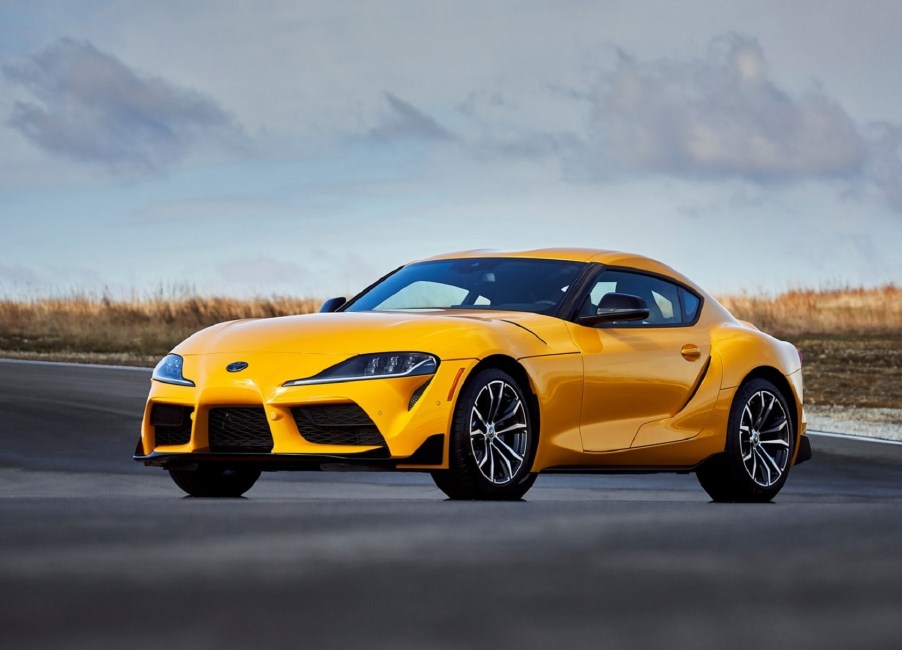
Critics Can’t Agree on the Four-Cylinder Toyota Supra 2.0
As welcome as the reborn Supra is, the latest version of Toyota’s iconic sports car has weathered a somewhat-mixed reception. Not least of which is the notion that it’s a badge-engineered BMW Z4 M40i. However, for the 2021 model year, Toyota has addressed some of the 2020 Supra’s faults. But the 2021 update also brings a new model: the Supra 2.0. And once again, it’s prompting divided opinions.
What’s different about the 2021 Toyota Supra 2.0?

For 2021, Toyota is offering the rear-wheel-drive Supra in 2 flavors, Road & Track explains. The $50,990 3.0-liter turbocharged six-cylinder model continues as the Supra 3.0. Meanwhile, the $42,990 Toyota Supra 2.0 comes with a 2.0-liter turbocharged four-cylinder that was previously a Europe-only model.
Obviously, with a smaller engine comes less power. The 2021 Toyota Supra 2.0 is rated at 255 hp and 295 lb-ft, Car and Driver reports. Meanwhile, as part of its 2021 update, the Supra 3.0 now makes 382 hp and 368 lb-ft, Car and Driver reports. But, based on Car and Driver’s dyno test, it may be making closer to 400 hp.
However, the smaller engine also makes the Supra 2.0 about 220 pounds lighter than the six-cylinder model, Automobile reports. Unfortunately, that’s not quite enough to make up the power difference. The four-cylinder Toyota Supra goes 0-60 in 4.7 seconds, while the heavier model does it in 3.8 seconds, Car and Driver reports.
The differences between the Toyota Supra 2.0 and 3.0 go beyond their powertrains, though. It has smaller front brake rotors, with single-piston rather than 4-piston calipers, Motor Trend reports. That might be why Car and Driver reports that the lighter Supra has the same braking distances as the six-cylinder model. Also, the four-cylinder model lacks the six-cylinder model’s adaptive dampers and its electronically-controlled limited-slip differential. However, it retains a mechanical limited-slip differential, R&T reports.

The content-cutting continues inside the cabin. The Toyota Supra 2.0 lacks standard adaptive cruise control, power-adjustable seats, and heads-up display, The Drive reports. It also has 4 speakers, rather than 10. Thankfully, the four-cylinder model can be equipped with adaptive cruise control with the Safety and Technology Package. The package also adds Apple CarPlay, navigation, blind-spot monitoring, and rear cross-traffic alert.
Why is the Supra 2.0 so divisive?
While the four-cylinder is the main point of contention with the 2021 Toyota Supra 2.0, it’s also subtly different from the Supra 3.0 in a few other ways. It has softer springs, R&T reports, slightly slower steering, and smaller wheels; that last difference also grants more tire sidewall.
That’s not to say the Supra 2.0 is any less fun as a sports car, R&T reports. The smaller wheels combined with less weight over the front actually make it feel nimbler than the Supra 3.0. And while the steering isn’t as frenetic, it’s still sharp and quick, The Drive reports. But even though the extra sidewall and different springs create a comfier ride, there’s still little-to-no body roll.
Also, the Supra 3.0’s extra power can work against it, Automobile reports. In addition to the livelier steering making the car feel more on-edge, the six-cylinder model’s rear is more eager to step out. In contrast, the Toyota Supra 2.0 offers “a much more approachable—and more friendly—driving experience,” Automobile reports. It’s just as easy to handle, if not easier, than the more-expensive Porsche 718 Cayman.
However, the Supra 3.0 is still faster than the 2.0 model. And if track-racing is your goal, it’s the better-suited of the two. Also, its turbocharged six-cylinder gives it a stronger connection to the beloved Mk4 Supra. Plus, the $8000-worth of extra standard equipment is certainly nothing to sneeze at.

Finally, if what you want is a four-cylinder, RWD Toyota sports car, there’s always the 86—which is even cheaper.
2021 Toyota Supra 2.0 vs. Supra 3.0 vs. 86: which should you get?
It is worth noting that the production of the Toyota 86, along with its Subaru BRZ platform-mate, is about to end. However, that’s only to make way for the next-gen models, Car and Driver reports. And there are rumors claiming the updated Toyota 86 will come with a 2.4-liter turbocharged flat-four engine with close to 260 hp. Meaning, it might be even closer in performance to the Supra 2.0.
So, does that make the Toyota Supra 2.0 pointless? Not necessarily, MT explains. For one, neither Supra models offer a manual, but the 86 does. With the latter car, it’s more about the sensations of driving, rather than outright speed. The Supra, meanwhile, is as much a long-distance GT as it is a sports car. That was the case with the Mk4 model too.
Choosing between the two Toyota Supra models depends on what you value more. If you like chasing lap times, the six-cylinder car is the one to get. But if you want to hustle down a back road and drive to the store, the Supra 2.0 is by no means a poor choice.
Follow more updates from MotorBiscuit on our Facebook page.


